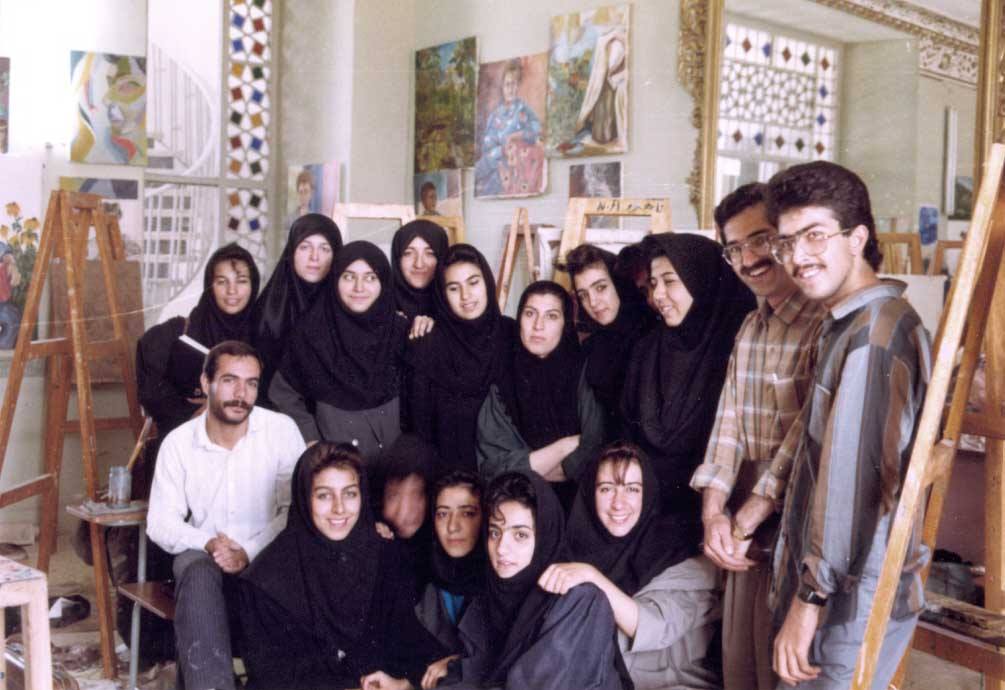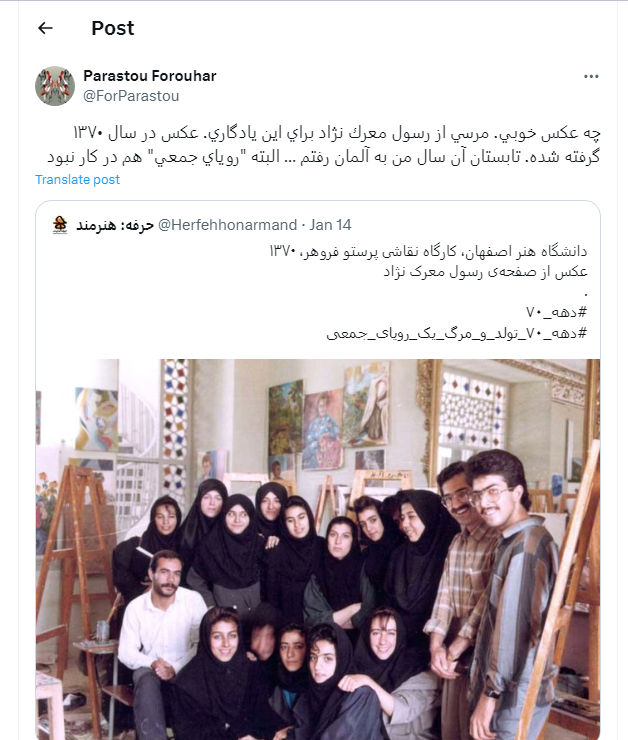REMEMBERING MY MENTOR IN PAINTING: PARASTOU FOROUHAR
Some people are more than mentors; they are transformational figures around whom our intellectual lives orbit and our lives take shape. They are the guides we never know we need, even as our paths diverge over time. So I want to write about two female artists who taught me how to design and the rules of painting, to think like an artist. Both were charismatic and art-loving, which was evident in how they treated the art world.

I started to go to the painting workshop in September 1990. There, in a blue sweater and sliding off the end of a chair, sat a woman about our age with students surrounding her. Her seriousness showed in her speech: direct, earnest and kind. She was Parastu Forouhar.
The university consisted of a two-story building nestled away in the greenery underneath Abshar Park, the setting of the movie “Ganjeh-e Gharoon” (The Treasure of Qaroun), quite riveting for many due to Fardin’s performance and the notorious hit, “Aqa khodesh khob midone ke ma oon ro az roodkhone deresh avordim birun avordim avordimesh to khone…” (Mr. knows very well that we brought him out of the river, out, brought him to home…). I have always been intuitive about painting, and it was this intuition that I sought when my early praise was given. During a handful of sessions, my instructor displayed my beginner’s painting, stressing the need for the piece to include both emotion and intellect. My painting depicted a chair, a chair with a dark shirt hung over its backrest, the darkness of the shirt leaving a profound impact on the viewer. My early work was really expressive, vibrant colors and a sort of raw simplicity with both the subjects and the color palette.
Not that it was required, but each of us created three to four paintings weekly. We would talk about our work, and also we used to practice during the workshop. Many times in these conversations, I didn’t have the words, as if I had been caught in a misty world then propelled into a rich one of art. Far from lamenting my ignorance or deficiencies, which I am now most certainly am, I owned the spaces between, and that acts as the turning point for further study. Painting and drawing were my ever-loyal friends even during the Norouz holidays.
Half of the first semester was spent in the workshop, and a second was spent painting from nature, on location. At times we crossed the city to the banks of the Zayandeh Rud River. We would establish ourselves in a confined space, always without the slightest trace of fatigue, being directed back and forth by Parastu Forouhar who circulated tirelessly there.
At that moment, my paintings siempre filled with bright colors slowly became more muted colors. I was writing personal essays steeped in social critique that I only shared with a handful of close friends and sometimes with Forouhar. She taught us not only how to paint, but also how to think, act, know and love each other better.
There was drawing, painting, studying and writing every day and little time for youthful activities. As a result, my friends thought I was less social. I would have two semesters of painting with Parastu Forouhar after which I did visit her home in Tehran a couple of times in 1991-1992. Once I got there at 5 a.m. and would always try to bring a book as a present for her sons, who were probably in elementary school. I waited in the alley and buzzed the doorbell. Her son picked up and said, “Mom has passed.” I then realized that they had left before I had. And that’s the way Tehran life works. They went inside; I waited outside, and when they came out, I went inside their home. She was getting ready to take her sons to school, so I was alone with the bookshelves, cassettes and a still life: a dark fabric swatch, a vase of sunflowers and some pieces of half-eaten fruit and a half-finished painting. When she came back, my mother and I talked briefly about art and painting. Parastu was on the scene and our conversation was brief yet at the time, I did not know that at the time I was meeting the daughter of Dariush and Parvane Forouhar.
It’s been some thirty years since then, but her then-nearly Pauline mission to instill a deeper appreciation of art always sticks in my mind. When I came across her still-life arrangement in her house, I was inspired to write a poem that’s in my book “Hand in the Mirror’s Hair.”
A Black Cloth Patch
A swatch of black fabric
Hangs
From the chair leg to the ground.
And your gaze
A Broken Line
Between two sunflower stems
Three naturally fallen fruits.
Eight lines
Converge at a single point.
And intertwine.
With the delicate lines of the glass
Endless.
And you?
Discover a concealed presence
Within the vibrant, geometric simplicity of objects.
I remain proud to have had a teacher who guided me along the right path of thinking, even though my artistic expression has since evolved in a different direction.
